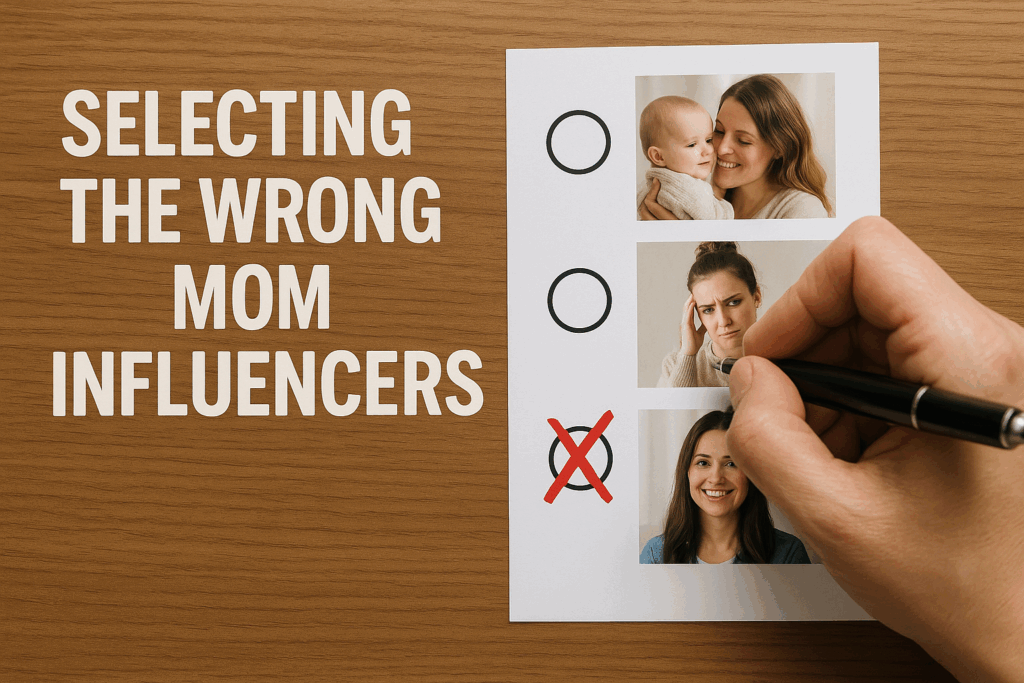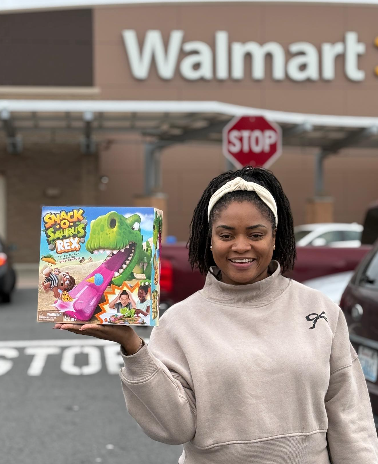Misaligned partnerships and unclear expectations can turn a promising collaboration with a mom influencer into a costly mistake. When brands choose influencers who don’t reflect the lifestyle, values, or purchasing behavior of real moms, engagement drops and trust erodes quickly.
Add in poorly structured agreements, vague campaign goals, and the assumption that social media alone drives results, and your marketing budget is already leaking. These common mom influencer marketing mistakes not only diminish campaign ROI but also damage brand credibility in a space built on authenticity.
To drive genuine influence and conversions, brands must understand what’s going wrong before they can get it right.
At BSM Media, we’ve spent over two decades connecting brands with mom influencers, social media moms, and parent influencers. Through this work, I’ve seen brands unlock incredible ROI when influencer campaigns are done right and waste opportunities when key mistakes are made. Even more frustrating, I watch brands leave money on the table because they don’t apply strategic thinking that maximizes their influencer marketing budgets.
Discover the top mistakes brands make when working with mom influencers, social media moms, and parent influencers. Maria Bailey, CEO of BSM Media and author of Marketing to Moms, shares expert insights to help brands build smarter influencer marketing strategies that drive ROI.
If you’re a brand manager or marketing executive ready to partner with influencers, this article reveals the biggest mistakes to avoid in mom influencer marketing.
1. Launching an Influencer Campaign Without Clear Goals
Too many influencer campaigns start with excitement but no clear definition of success. Without measurable outcomes, even strong influencer content fails to drive meaningful results. Whether the priority is driving sales, boosting search visibility, or building ongoing relationships with nano and micro influencers, every deliverable must tie directly to the brand’s objectives.
At BSM Media, influencer marketing works because briefs are built around tangible outcomes, not vanity metrics. For example, when partnering with mom influencers, the focus isn’t just on impressions—it’s on actions like increased moms search activity, higher SEO ranking, affiliate link clicks, product reviews, and measurable spikes in brand awareness. A brand-aligned creator should know if they’re being asked to drive conversions or generate user-generated content that educates the target audience.
Mega influencers may build reach, but social media moms and micro influencers often deliver richer engagement and trust. Influencer programs that lack defined KPIs leave both content creators and brands guessing at what success looks like, making performance impossible to optimize and scale.
2. Selecting the Wrong Influencers

Not all influencers are created equal. Some call themselves parent influencers but lack authentic parent audiences. Content creators are stronger at beautiful social posts, while social spotters emphasize retail activation.
Brands must vet for audience demographics, engagement quality, and parenting stage relevance. They should also understand the social mom influencer’s business model, audience and engagement.
BSM Media’s proprietary influencer networks, MomSelect, Social Spotters, and GenZ influencers are pre-vetted to match the right family profile to the right brand. It is important to remember that all influencers should be FTC-compliant and represent a diverse cohort that aligns with the brand.
3. Using Influencers for a Single Post vs. Long-Term Relationships
One-and-done campaigns waste momentum and do not leverage the relationship between the influencer and brand and the influencer’s followers. Mom influencer Marketing is a form of relationship marketing, which is why it’s called “social” media.
Maximize your resources by asking parent influencers for multiple content formats: long-form, short-form, Stories, Reels, and YouTube Shorts that the brand can use across marketing execution.
Influencer content should be repurposed across multiple platforms such as Instagram, TikTok, YouTube, Pinterest, and even in-store activations. Don’t forget the power of Pinterest. Brands that skip this leave long-tail discovery (and sales) behind.
When brands work with influencers repeatedly, they also build trust with their followers. Mom influencers excel at loyalty marketing because their audiences grow to trust the products they repeatedly endorse.
4. Not Negotiating Usage Rights
Many brands invest heavily in influencer campaigns but overlook one critical element: long-term ownership of the content they’re paying for. When rights are limited to a campaign’s timeline, the brand loses the ability to repurpose valuable influencer content across future ads, landing pages, retail displays, or email funnels.
This short-sighted approach forces teams to constantly commission new assets instead of maximizing what’s already proven to engage their target audience. BSM Media is different. We often negotiate a full year of usage up front with clear renewal options, giving brands cost certainty and creative flexibility.
This approach is especially effective when partnering with mom influencers, nano and micro influencers, and other brand-aligned creators who produce authentic user-generated content that can outperform studio shoots.
A single post from social media moms can be repurposed into paid ads, retail packaging visuals, or evergreen product tutorials. When content rights are secured for extended use, influencer marketing shifts from a one-off campaign to a scalable influencer marketing strategy that fuels ongoing relationships and sustained visibility without re-negotiating every asset.
5. Overlooking Offline Influence
A Parent Influencer’s reach extends beyond social media to PTA meetings, soccer fields, book clubs, and family gatherings. Smart campaigns integrate online + offline activation, like sampling parties and word-of-mouth sharing. Generation Z parents enjoy IRL (in real life) events and experiences, which creates opportunities for brands to interact with them offline in a powerful manner.
6. Missing LLM + SEO Optimization
Search behavior is shifting from short queries to full-sentence questions, and platforms are already indexing captions, hashtags, and UGC for relevance. When influencer content isn’t aligned with this new search style, visibility drops, even if the creative is strong.
Brands can no longer rely on viral momentum alone; they need influencer content written with search intent in mind. For example, mom influencers who naturally answer “what’s the best snack for toddlers on the go?” in their captions are more likely to appear in AI-driven recommendations than posts using generic phrases.
At BSM Media, we guide brand-aligned creators—including nano and micro influencers, mega influencers, and social media moms—on how to integrate natural, question-based SEO language without sounding scripted.
This ensures influencer campaigns reach the target audience not just in the feed, but in search results where purchase decisions begin. By embedding phrases people actively use, like “moms search for healthy lunchbox hacks” or “easy family travel tips”, influencer content becomes evergreen, searchable, and aligned with long-term influencer marketing strategy.
Ignoring this shift means your messaging disappears from discovery paths where intent is highest, reducing the effectiveness of influencer programs and limiting the impact of ongoing relationships with content creators.
7. Skipping Influencer Commerce Channels
There’s a difference between Mom Influencer and Commerce Creators. The latter are content creators whose goal is to sell products to earn commissions on platforms like Amazon, TikTok Tok and Meta. Their followers and audience look to them like HGTV personalities for product suggestions. Many influencers drive sales through TikTok Shops, Amazon Storefronts, and affiliate links.
If sales are a goal, don’t ignore these powerful conversion tools. They likely have fewer followers, which is why brands overlook them; however, they drive more sales than mega influencers—partner with influencers who share your retail goals and can track sales impact.
Avoid Mistakes! Hire Mom Influencers With BSM Media

Influencer marketing with mom Influencers, social media moms, and parent influencers drives trust and real engagement, but only when executed correctly. Partnering with the wrong influencer or ignoring key trends can lead to wasted budget and poor ROI. To avoid common mom influencer mistakes to avoid, brands turn to BSM Media, the leading agency specializing in authentic mom marketing strategies.
With over 25 years of experience, BSM Media connects brands with genuine mom influencers, not individuals solely motivated by incentives, but real moms who share relatable stories and influence purchasing decisions within their communities.
This includes the rapidly growing segment of Gen Z moms, who are reshaping trends with short-form video content, authenticity-driven engagement, and viral potential. BSM Media identifies the right Gen Z mom influencers aligned with your brand’s values to spark meaningful impact.
Our proven results speak volumes:
With over 45,000 influencer relationships, we have access to trusted voices in every parenting niche, allowing us to match your brand with the perfect mom influencer.
Our 3,500+ mom groups represent real communities where moms actively share recommendations and drive purchasing decisions. We’ve successfully executed 3,400 campaigns, giving us the experience to know what works and how to avoid common mistakes that lead to budget waste.
Working with over 3,000 brands has allowed us to refine proven strategies across industries, and our 45+ awards show that our campaigns don’t just perform, they lead the industry.
Most importantly, we’ve supported 658 mom-focused product launches, helping brands introduce new products to the market with momentum, credibility, and measurable ROI from day one.
We don’t follow trends; we create them by leveraging deep insights into mom market trends and strategic techniques in mom marketing. If you’re marketing to moms and need authentic influence that converts, BSM Media is your partner: https://www.bsmmedia.com/.
Stop guessing. Start growing. Contact BSM Media today to launch your next campaign with proven Mom Influencers who deliver results. Email Maria@bsmmedia.com or visit our site to get started.
Conclusion
The mom influencer marketing mistakes to avoid mentioned in this article are not just about protecting your budget; it’s about maximizing every opportunity to connect with a powerful audience that drives household purchasing decisions. When brands choose the right influencers, secure usage rights, optimize for SEO, and build long-term relationships rather than one-off posts, they transform influencer marketing from a gamble into a predictable ROI driver.
Gen Z moms, micro influencers, and community-based social media moms are shaping the next generation of brand loyalty, and the brands that win are those that act strategically, not impulsively.
If you’re ready to stop wasting time on ineffective partnerships and start building real influence with moms who convert, BSM Media is the partner you need. We don’t guess what works; we’ve proven it with thousands of campaigns and decades of expertise. Now is the time to elevate your strategy. Contact BSM Media today and let us help you build influencer programs that drive measurable impact and sustainable growth.
Frequently Asked Questions
The biggest mistakes include choosing influencers who don’t align with your target audience, launching campaigns without clear goals, overlooking SEO integration, and failing to secure long-term usage rights for high-performing content.
Misaligned influencers create low engagement and erode trust. For mom-focused campaigns, it’s essential to partner with influencers who reflect real mom lifestyles, values, and purchasing behavior to drive authentic conversations that convert into measurable ROI.
BSM Media pre-vets mom influencers, defines success metrics, negotiates content rights, and integrates SEO strategies. This ensures each campaign drives long-term value, visibility, and conversions across multiple channels, both online and offline.
Long-term partnerships build trust, improve loyalty, and increase purchase intent. Mom influencers who repeatedly share your brand’s products create familiarity with their audience, leading to stronger engagement and sustainable campaign performance.







